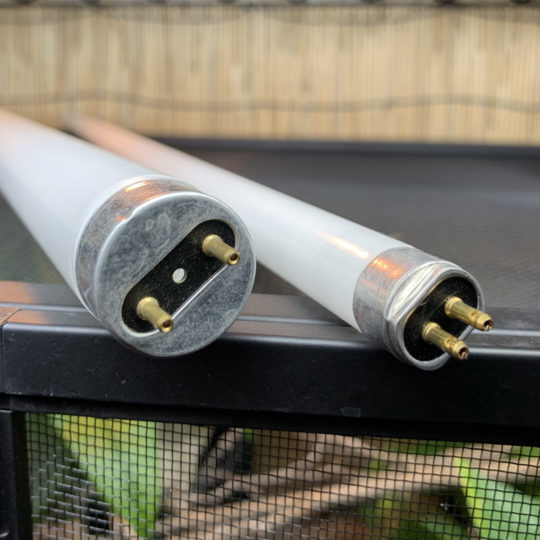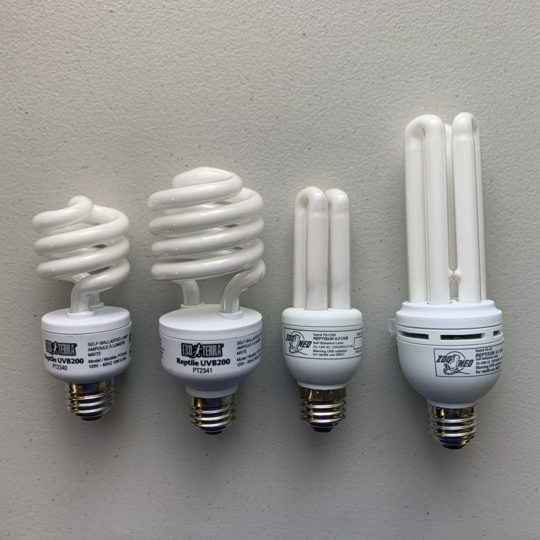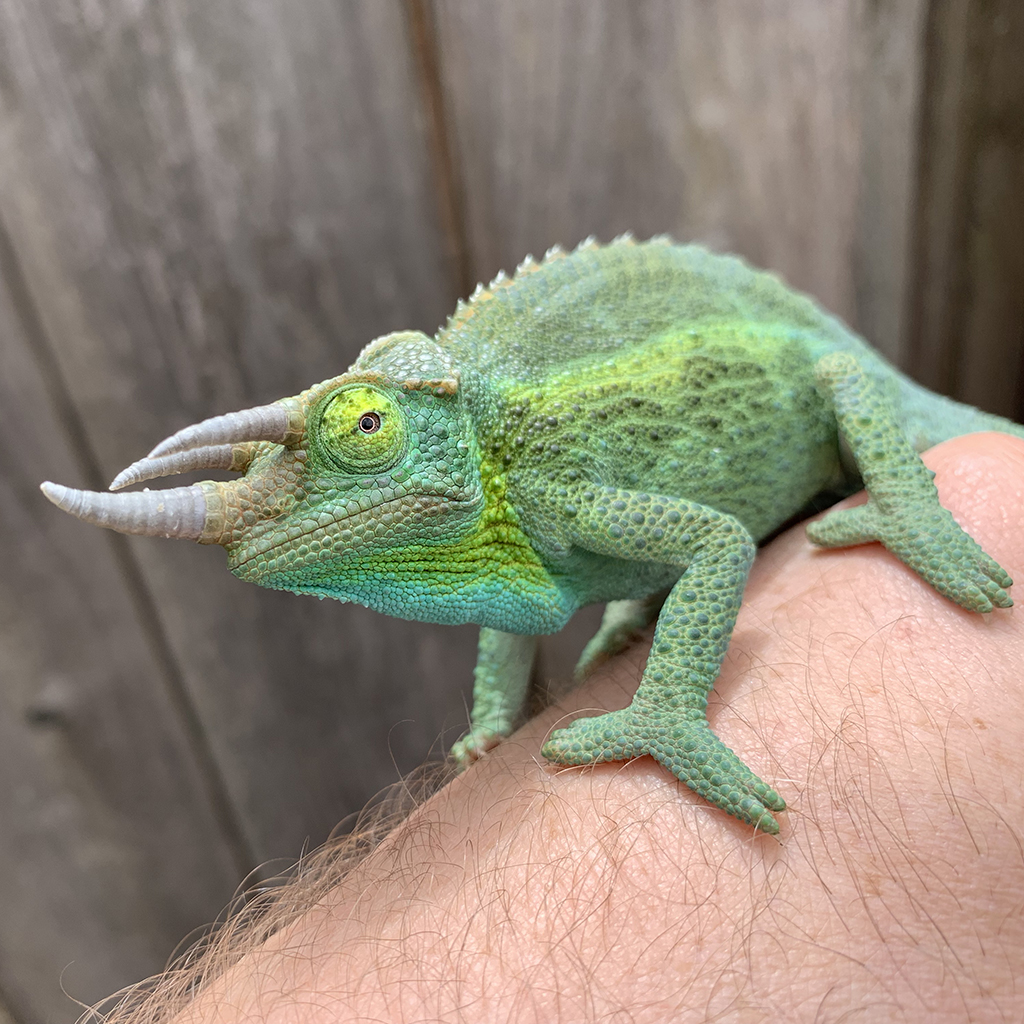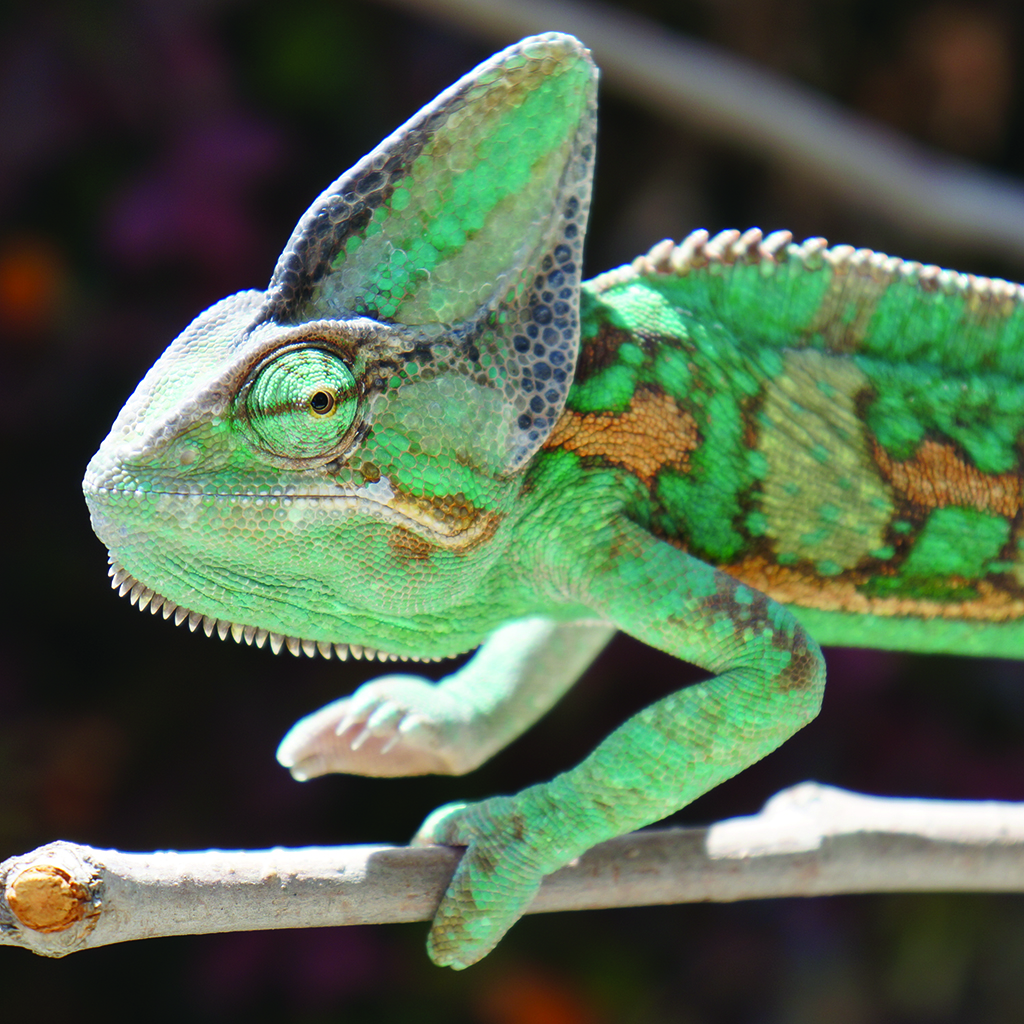Summary: UVB for your Chameleon
- UVB is a critical component to chameleon health
- UVB is a special light wavelength from the body uses to make vitamin D3
- Vitamin D3 is necessary for the body to use calcium
- T5 High Output Fluorescent bulbs are the lighting technology of choice
- The standard recommended UV Index for Veiled, Panther, and Jackson’s Chameleons is between 3 – 6
Introduction
The effects of UVB on chameleon husbandry is a difficult subject to write on because there is so much we do not know. We know that certain wavelengths of UVB energize the chameleon’s body to produce D3 and that, without vitamin D3, calcium cannot be absorbed. A lack of calcium leads to painful death from Metabolic Bone Disease (MBD). MBD is the most common preventable cause of death in captive chameleons.
While UVB is part of a critical health process, the challenge is knowing how much they require in captivity. Like all things, there can be too little and too much and in both cases there are health issues. In the wild the amount of UVB they are exposed to is heavily regulated by how much they bask, when they bask, or even if they bask at all. Anecdotal behavior evidence suggests that they purposefully regulate their exposure not only for heat, but also for UVB. Numerous members of the breeding community have noticed “UVB basking”. It is unknown how this behavior changes with respect to species.
UV levels are measured in UV Index ratings. These can be measured by a Solarmeter 6.5 UVB meter. There was an earlier model, the Solarmeter 6.2 which measured in uWatts/cm^2. We no longer use this method as it measured a wider number of wavelengths. The Solarmeter 6.5 is much more focused on the wavelength levels that are responsible for D3 conversion.
So we are left to figure out what UVB level we should provide in our cages. In the wild a chameleon has a gradient over time. At night they have UVI of zero and they can bask at any time until the afternoon where the UVI reaches 11 or above in many ranges. Normal chameleon behavior is to bask in the morning so they are getting UVI 2-3 (VERY rough estimate). In our standard caging systems we offer one level of UVB through out the day (although some creative souls have experimented with controlling intensity by turning on and off additional UVB lights throughout the day). Do we offer the morning intensity throughout the day allowing for basking anytime during the day? The highest levels? Or some level in between? This is still being experimented with.
There is much work to be done, but at this moment of time, it appears that a UVI between 3 and 6 at the basking spot is effective in D3 production in the most common species. Please read on to learn a little bit more about UVB and chameleons.
What is UVB?
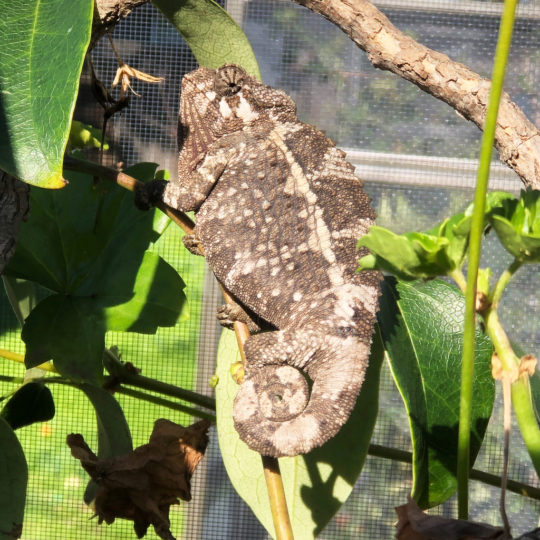
The spectrum of light that radiates Earth includes wavelengths outside our human field of view. In the more energetic range outside our view, the ultraviolet range, there are a small range of frequencies, 280nm to 300nm, that our skin uses in the process to produce vitamin D3. Vitamin D3 is actually a hormone and is a critical building block for our bodies. Vitamin D3 is what allows the body to pull ingested calcium out of the digestive tract. Without vitamin D3, ingested calcium flows uselessly through the digestive system and out the body with the rest of the waste. Chameleons work the same way. Calcium is a critical component to building bones and the proper function of organs. This is a highly complicated process that involves the liver and the kidneys. And any break in that cycle causes calcium to be lost even if calcium is in ample supply on the feeder insects.
Dietary D3 vs UVB

Another way to get Vitamin D3 into the body is to include it with our supplementation. Synthetic vitamin D3 provides the same function as the D3 produced by UVB radiation. In fact, in the years before UVB lights were available, dietary D3 was able to sustain captive chameleons for a long healthy life.
Unfortunately, there is a real danger in dietary D3. Dietary D3 bypasses all the checks and balances the chameleon’s body has in the D3 production loop. You can never have too much D3 when providing UVB because the chameleon’s body will stop D3 production once it has what it needs. Your chameleon will reduce production of vitamin D3 via UVB if it gets dietary D3, but it is not able to stop the absorption of D3 from the gut. And here is the danger. Giving the final form of D3 through the diet fills the chameleon’s body up without knowing how much they need. This is an issue because Vitamin D3 is a fat soluble vitamin and that means there is a danger of over-supplementation.
This is not a reason to panic as vitamin D3 supplementation has been used successfully for many decades. There is a well known safe zone that you can operate in. But we will be pushing towards a full UVB system as much as is possible as chameleons were designed to get minimal vitamin D3 through their diet and, thus, have not developed a defense against overdose via diet.
The UVB cycle in the Wild

The UVB wavelengths we are most interested in are measured in units of UV Index. At night the UVI is zero and how high it climbs during the day depends on season and location on the globe. The more direct the sunlight the higher the UVI. In a typical scenario, in the mornings, before 10AM the UVI builds up to around 2. You then get a jump in UVI all the way up to 10 or higher from 10AM an on as the sun is in the highest point in the sky. And then, the UVI drops as the sun starts moving towards the horizon. We can get back down to a UVI of 2 around 5 or 6 PM.
The significance of this is that the daily habits of chameleons are usually to come out in the morning, get their core temperature warmed up via basking, and then retreat into the leaves before the sun gets too hot. This means that in the wild they are basking when the sun is providing UVI of 1 – 3. Just like us humans concerned about sun burns, so chameleons hide away from intense sunlight. They are certainly active, but they stay in the cover of the leaves and out of the intensity of the afternoon sun. Thus, looking up the UVI of the region chameleons come from will give you an incorrect reading regarding what they are exposing themselves to.
In captivity, we currently advise a UVI around 3 at the chameleon’s basking branch. This is for systems that are using UVB for vitamin D3 conversion. UVB is the natural and safest way for the chameleon to get their vitamin D3, but we are still working on definitive answers as to how much UVB is needed and how best to supplement. While our technology and advancements are excellent and have proven time and again to be effective, there is still an enormous amount of work needing to be done before we can say with certainty we have the answer. UVI 3 has been shown to be effective in both Veiled and Panther Chameleons and work continues to determine what levels would be effective in other species. While sustaining life is the minimum milestone, the most effective test is a female raised up in the UVB test conditions and producing fully calcified eggs. If she can produce fully calcified eggs without dietary D3 supplementation then we accept that the UVB level has been proven effective. This has been done repeatedly with both Veiled and Panther Chameleons.
Artificial sources of UVB
We have a number of options when considering artificial UVB sources. The most commonly used source is the T5 linear fluorescent light bulb. There are weaker bulbs such as the T8 (which is larger, but less powerful) and stronger Metal Halide bulbs. There are also fluorescent bulbs made in such a way that they fit into normal light sockets. These are referred to as Compact Fluorescent Lights.
In term 1 we will work mostly with the T5 linear fluorescent bulbs, but will learn the basics that apply to all bulbs so you can make an intelligent decision as to what you use.
With these bulbs there will be a handful of terms that are useful to know.
T5: This is the terminology used to measure the diameter of the bulb. Diameters are measured in 1/8″ steps. A T12 size bulb would be 12/8ths or 1 1/2″ in diameter. A T8 would be 8/8ths or 1″ in diameter. And a T5 would be 5/8″ in diameter. It may not be intuitive, but every step down in size is actually a step forward in technology and each step down is more powerful and efficient than the last. At this point T5s are the leading size.
5.0/10.0/6%/12%: When working with UVB bulbs the UVB strength is measured as what percentage of light produced is UVB. The U.K. based company Arcadia Reptile produced a number of strengths. The most common for us chameleon keepers is the 6% and 12%. Though there is 14% for special situations. The American based ZooMed produces the 5.0 and 10.0 which are 5% and 10% strengths. There have recently been a surge of second or third tier brands offering UVB bulbs which are, most assuredly, coming from the same factory. This has peppered the market with options that are not well measured or understood. Luckily, Arcadia and ZooMed UVB bulbs are readily available and there is no need to experiment with more confusing options.
Linear vs. Compact Fluorescent Light (CFLs): The glass tubes that comprise the UVB bulbs can be formed either as a long tube or it can be spiraled or bent back on itself. The straight tube is a linear bulb. The bent or spiraled forms are called Compact Fluorescent Lights and are meant to provide a more efficient way of lighting a home using existing sockets. The linear bulbs are the standard in the chameleon industry as it is easier to create a useful larger gradient. Compact Fluorescents have been given a bad reputation due to the weakest version being included in the ZooMed Chameleon Kit. This T5 HO 5.0, 13W CFL has a useful gradient of a couple of inches and, although this can be used effectively for very small chameleons, without an education in proper use of the tool, most chameleons in the Chameleon Kit end up without the benefit of UVB.
UVB LEDs: As technology moves forward we mist move forward as well. Fluorescent lights are now being phased out. This will take a while and there are some exceptions being made for specialty lighting, but the writing is on the wall that we will transition to UVB LEDs in the near future. This presents a challenge because we have gotten so used to working with fluorescent bulbs. The problem is that the spectrums are not identical and so, even if the reading on our Solarmeter is the same under a T5 as it is an LED, we may get different results as far as health because of the spectrums outside the UVB that are present or absent. I will present the wealth of knowledge and experience we have with fluorescent bulbs. They are highly effective, but the Chameleon Academy will be methodically transitioning to LEDs as the world does. At the time of this update (2024), UVB LEDs are new and it is a good idea to put some time into testing them before having beginners use them. So, use the well tested, safe, and effective T5 UVB bulbs for now. But, in the years to come, we will have to transition.
There are two main types of Compact Fluorescent Lights. The U type and the “pigtail” type. A CFL is simply the same fluorescent technology as the linears, but the tube is formed into a different shape. If you decide to use a CFL, then a reflector should be used to focus the energy. Like the linears, they will shine light in all directions. A reflector gathers the light and sends it in the right direction.
Setting up Your
UVB
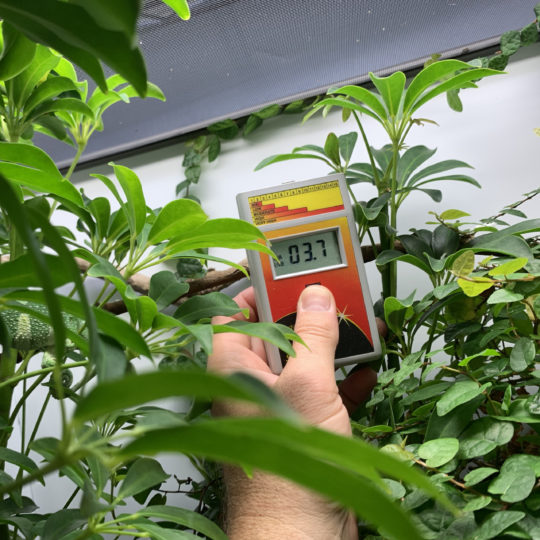
The strength of the linear fluorescent UVB light that hits the basking branch in your chameleon cage is affected by many parameters.
Reflector. Fluorescent tubes radiate light in all directions. If you have no reflector on the fluorescent fixture then you are getting about 25% of the bulb’s light going in any one direction. If you put this bulb in a reflector, all the light radiated away from your basking branch is reflected back and you are getting the full light output focused in one direction.
Other bulbs. The top strength would be to use a single bulb reflector. If you use a dual bulb reflector your UVB strength could be reduced to 25% to 75% of top strength depending on whether the UVB bulb is next to one bulb or sandwiched in between other bulbs.
Screen. We generally place our UVB bulbs on top of a cage so the light goes through the screen top. This can reduce the UVB level by about 30% for the common cage manufacturers.
Distance. When you measure the UV Index readings from the lamp you will find a drastic decrease in strength every inch you go to the point where there will be essentially no UVB. But caution must be taken as the strength at the top of your screen cage may be at levels not found naturally on Earth. This becomes an issue if you are keeping small chameleons that will crawl upside down on the cage top and expose their bellies to the UVB lamp sitting on top of the cage.
Conlcusion
We will spend a great deal of time learning about UVB. It is a critical component in our nutrition and supplementation decisions. In the module on Setting Up Your Chameleon Cage you will learn more about how to apply a UVB light to a cage effectively.
(If you are specifically interested in UVB then you may jump to the execution page here Chameleon Cage Set-up: Replicating the Sun )
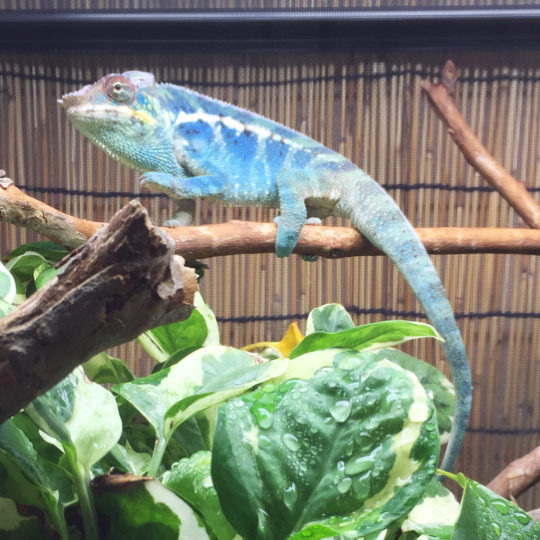
Navigation
This seminar is part of the introductory course Chameleon Basics which, in turn, is a module within the even larger Term 1: Getting Started With Chameleons.


